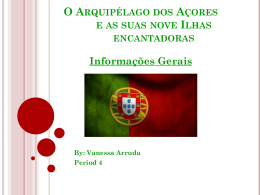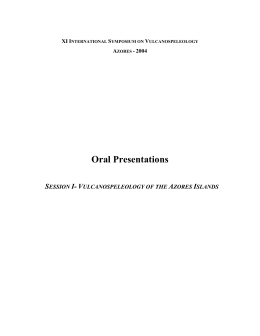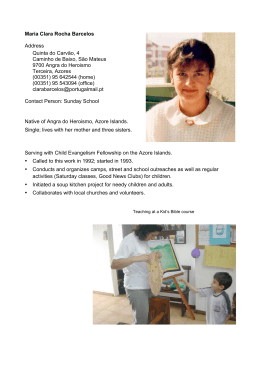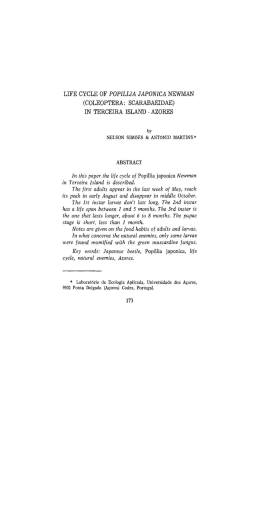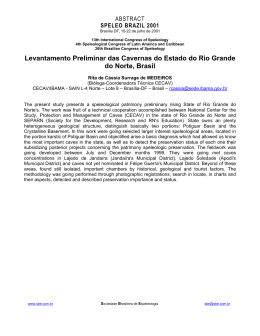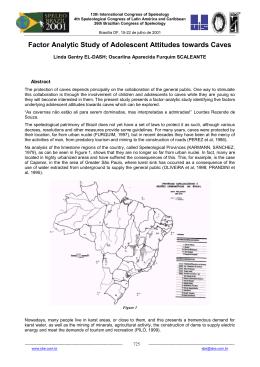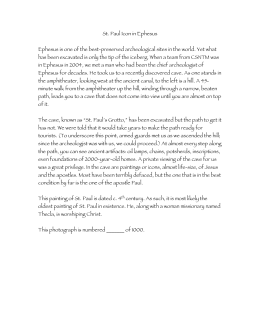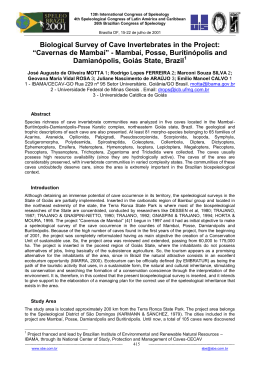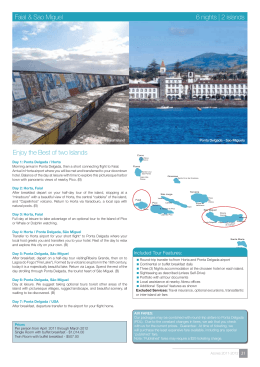INDICATORS OF CONSERVATION VALUE OF AZOREAN CAVES BASED ON ITS ARTHROPOD FAUNA Paulo A.V. Borges 1,2, Fernando Pereira 2, João P. Constância 3 1- Universidade dos Açores, Dep. Ciências Agrárias, CITA-A, 9700-851 Angra do Heroísmo, Terceira, Açores; Email: [email protected] 2- “Os Montanheiros”, Rua da Rocha, 9700 Angra do Heroísmo, Terceira, Açores 3- “Amigos dos Açores”, Avenida da Paz, 14, 9600-053 Pico da Pedra, S. Miguel Abstract: All Azorean lava-tubes and volcanic pits with fauna were evaluated for species diversity and rarity based on arthropods. To produce an unbiased multiple-criteria index (importance value for conservation, IV-C) incorporating arthropod species diversity based indices and indices qualifying geological and management features (e.g. diversity of geological structures, threats, accessibility, etc.), an iterative partial multiple regression analysis was performed. In addition, the complementarity method (using heuristic methods) was used for priority-cave analyses. Most hypogean endemic species have restricted distributions, occurring only in one cave. It was concluded that several well-managed protected caves per island are absolutely necessary to have a good fraction of the endemic arthropods preserved. For presence/absence data, suboptimal solutions indicate that at least 50% lava-tubes with known hypogean fauna are needed if we want that 100% of endemic arthropod species are represented in a minimum set of reserves. Based both on the uniqueness of species composition and/or high species richness and geological value of the caves, conservation efforts should be focused on the following caves: Gruta da Beira, Algar das Bocas do Fogo (S. Jorge); Montanheiros, Henrique Maciel, Soldão, Furna das Cabras II and Ribeira do Fundo (Pico); Algar do Carvão, Balcões, Agulhas and Chocolate (Terceira); Água de Pau (S. Miguel); Anelares and Parque do Capelo (Faial). 1. INTRODUCTION Caves as islands are isolated entities, and, as a consequence, they lack the “rescue effect”: only “source” species can be maintained in ecological and evolutionary time (Rosenweig 1995). Thus, cave species could be considered as very restricted in distribution due to their low dispersal abilities and cave islolation. However, cave-adapted species could disperse between cave systems throughout the MSS (”Milieu souterrain siperficiel” or “Mesovoid Shallow Substratum” sensu CULVER, 2001). This is the case of Trechus terceiranus, a troglobian species found in many caves from Terceira island (Azores) but also in the MSS (Borges 1993). Than, it is important to investigate how widespread are cavernicolous fauna to better conserve it. The conservation of the rich Azorean cave-adapted fauna (Borges & Oromí 1994) is urgent but the resources are not enough to protect all caves. Consequently, there is a need to set priorities for conservation. The aim of this study was to examine the faunistic relative value of a set of well sampled lava tubes and volcanic pits in the Azorean islands as a management tool to improve the conservation of Azorean cave-adapted arthropod biodiversity. We examined the following hypotheses: a) Using an iterative partial regression analyses to produce a multiple-criteria index incorporating diversity and rarity based indices, at least one cave per island will be highly ranked. This follows the assumption that the dispersal rates of species are low and consequently there is a high level of island-restricted endemism. b) The restricted distribution of endemic species will imply that most caves are unique and largely irreplaceable. Consequently, most caves will be needed to ensure each species is included at least one time in a complementary based approach. 2. METHODS Sites and data This study was conducted in the Azores, a volcanic Northern Atlantic archipelago that comprises nine islands, as well as several islets and seamounts distributed from Northwest to Southeast, roughly between 37º and 40º N and 24º and 31º W. The Azorean islands extend for about 615 km and are situated across the Mid-Atlantic Ridge, which separates the western group (Flores and Corvo) from the central (Faial, Pico, S. Jorge, Terceira and Graciosa) and the eastern (S. Miguel and S. Maria) groups (Figure 1). All these islands have a relatively recent volcanic origin, ranging from 8.12 Myr B.P. (S. Maria) to 250 000 years B.P. (Pico) (Nunes 1999). AZORES Corvo (0.71) Flores (2.16) Graciosa (2.50) S. Jorge (0.55) Terceira (3.52) Faial (0.73) Pico (0.25) S. Miguel (4.01) S. Maria (8.12) Figure 1. The nine Azorean islands with indication of their geological age based on data from Nunes (1999). In this study a total of 37 volcanic cavities distributed on six of the nine Azorean islands (excluding S. Maria, Flores and Corvo) were surveyed and are listed in Table 1. Some of those caves were surveyed intensively during 1988 and 1990 with two expeditions of “National Geographic” under the supervision of Pedro Oromí (Univ. de La Laguna) and Philippe Ashmole (Univ. de Edinburg) (see Oromí et al. 1990). However, many of the caves were also sampled by investigators of the University of the Azores and “Os Montanheiros” (see Borges & Oromí 1994). Part of the arthropod data on the presence/absence in the caves is unpublished and resulted from recent surveys performed by PB and FP. Arthropods were classified to one of three colonization categories: natives, endemics and introduced. In cases of doubt, a species was assumed to be native. Moreover, following information available in Borges & Oromí (1994) all the species were also classified as cave-adapted (troglobites) and non cave-adapted. Table. List of the lava tubes (LT) and volcanic pits (VP) investigated. Island Faial Faial Faial Faial Graciosa Pico Pico Pico Pico Pico Pico Pico Pico Pico Pico Pico Pico Pico S. Jorge S. Jorge S. Miguel S. Miguel S. Miguel S. Miguel S. Miguel Terceira Terceira Terceira Terceira Terceira Terceira Terceira Terceira Terceira Terceira Terceira Terceira Cave Furna Ruim Gruta das Anelares Gruta do Cabeço do Canto Gruta do Parque do Capelo Furna do Enxofre Furna da Baliza Furna de Henrique Maciel Furna do Frei Matias Furna dos Vimes Furna Nova I Furnas das Cabras II (terra) Gruta da Agostinha Gruta da Ribeira do Fundo Gruta das Canárias Gruta das Torres Gruta do Mistério da Silveira I Gruta do Soldão Gruta dos Montanheiros Algar das Bocas do Fogo Gruta da Beira Fenda do Pico Queimado Gruta de Água de Pau Gruta do Enforcado Gruta do Esqueleto Gruta do Pico da Cruz Algar do Carvão Furna de Santa Maria Gruta da Achada Gruta da Madre de Deus Gruta da Malha Gruta das Agulhas Gruta do Caldeira Gruta do Chocolate Gruta do Coelho Gruta do Natal Gruta dos Balcões Gruta dos Principiantes Type VP LT LT LT VP LT LT LT LT LT LT LT LT LT LT LT LT LT VP LT VP LT LT LT LT VP LT LT LT LT LT LT LT LT LT LT LT Data analysis For prioritizing the 37 caves two techniques were used: i) indices for scoring conservation priorities based on comparative analyses; ii) the complementarity method. i) Scoring method Due to its simplicity a scoring approach was used with 9 different indices, incorporating arthropod species diversity based indices, but also indices qualifying cave geological and management features (data from IPEA database, Constância et al. 2004). (see Table 2). However, as the several indices give quite different ranking of the caves results a multiple criteria index was applied. Table 2. The list of indices used to rank the caves. Code Index Explanation Strogl S trogobites The number of cave-adapted species Send S endemics The number of endemic species Srare S rare The number of rare species (those that occur in only one cave) Show Show cave index GEO DIF.Expl. Integrity Threats Acess. Geology index 0 No information available 1 Small cave (less than de 100 x 2 m). 2 Small and simple cave but with at least 100 m and less than 200m 3 Size between 200 and 500m but few interesting structures 4 Large size caves ( more than 500m) and with diversity of structures 5 Large size caves ( more than 1000m) and with diversity of structures 0 No information available 1 Relevant geological structures not present 2 Presence of very common geological structures (e.g. lava stalactites) 3 Presence of common geological structures (e.g. benches, striated walls) 4 Presence of rare geological structures (e.g. Secondary deposits, levees, different levels of tunnels, etc.) 5 Presence of very rare geological structures (e.g. Gas bubbles, stalagmite, columns) Difficulty of 0 No information available Exploration Index 1 Lava tube or pit of difficult exploration due to difficulty of progression 2 Lava tube or pit of difficult exploration in some parts due to difficulty of progression 3 Cavity with some obstacles 4 Presence of some obstacles but easy to transpose 5 No obstacles - all people could visit the cave 0 No information available 1 More than 50% of the cavity destroyed 2 some evidences of destruction (< 50% of he length) Integrity index Treats index Acessibility index 3 More than 90% of the lenght well preserved but presence of Human alterations or disturbance 4 Well preserved and few signals of Human alterations or disturbance 5 Very well preserved 0 No information available 1 The cavity has destroyed parts due to epigean land-use changes and disturbance 2 Well known epigean Human activities are identified and could cause near-future disturbance 3 Well known epigean Human activities are identified and could cause future disturbance 4 Well known epigean Human activities are identified but with non potential threat to the cavity 5 Non occurrence of Human activity or threats in the area of the cave 0 No information available 1 Very difficult to access - no roads or tracks available 2 Difficult access, far from near locality and more than 45 m walk 3 Difficult access, far from near locality or need of special permission of the property owner 4 Easy access, with available public transport 5 Easy access, easy to locate, near a locality Multiple criteria Index: Importance Value for Conservation (IV-C) When different values or criteria are combined in a single index, it is difficult to know what the single value obtained from it represents (see Borges et al. 2005). Moreover, the different indices used to describe a cave value may not be unrelated, thus leading to the possibility of giving a higher weighting to a given feature in the construction of the complex index. To avoid possible problems of collinearity we have used partial regression analysis techniques (Legendre & Legendre 1998, see also Borges et al. 2005), which allow the separation of the variability of a given predictor that is independent (i.e., non related) from the variability of another variable, or set of variables. To do this, we applied generalised linear models (GLM) with natural logarithm link functions, in which the predictor is regressed against this variable, or group of variables, and the resulting residuals are retained as the independent term of the variable. In this particular case, we have developed iterative partial regression analyses, each time extracting the variability of a predictor that is independent of the formerly chosen indices. That is, after selecting a first index (A), which is used without any transformation in the Importance Value for Conservation (IV-C) calculations, we regressed the second one (B) against A, obtaining its residuals (rB). In successive steps, each index (e.g., C) is regressed against the formerly included (in this case, A and rB) in a multiple regression analysis, obtaining its residuals (rC). The first selected index to be used without any transformation was the total number of endemic species (Strogl.), since cave-adapted species richness was considered to be of major importance to cave conservation. The other indices entered in the model by decreasing order of their r2 values of a GLM regression of each index with Strogl... Thus, the final Importance Value for Conservation (IV-C) composite index is as follows: IV-C = [(Strogl. / Strogl. max) + (RSend. / RSend. max) + (RShow / RShow max) + (RSrare / RSrare max) + (RGEO / RGEO max) + (RDif.Expl. / RDif.Expl. max) + (RIntegrity / RIntegrity max ) + (RThreats / RThreats max ) + (RAccess. / RAccess max )] / 9 in which for a reserve the value of the residual variance (R) of each of the additional indices is divided by the maximum value (max) obtained within all reserves. For instance, the residuals of “Show” were obtained after the following polynomial model: Show = a + b Strogl. + c RSend. This composite index has a maximum value of 1 (see also Borges et al. 2005). ii) Complementarity To obtain the minimum set of caves that combined have the highest representation of species we applied the complementarity method (Williams 2001). We used a heuristic suboptimal simple-greedy reserve-selection algorithm in an Excel Spreadsheet Macro. First, the cave with the highest species richness was selected. Then, these species are ignored and the cave with the highest complement of species (that is, the most species not represented in the previous selected cave), and so on, until all species are represented at least once. This method was applied to a dataset comprising only presence-absence data for the cave-adapted arthropods, to have the minimum set of caves to represent all species at least once. 3. RESULTS We recorded 35 species of endemic arthropods in the 37 caves (see Appendix 1). From those species, 19 (54%) are cave-adapted species. Most hypogean endemic species have restricted distributions, occurring only in one cave (Fig. 2). 12 Number of species 10 8 6 4 2 0 1 2 3 4 5 6 7 8 9 10 -- 16 Number of caves Fig. 2. Frequency distribution of Azorean troglobitic species in volcanic caves. Table 3. Ranking of the 37 caves in terms of the multiple criteria index, Importance Value for Conservation (IV-C). Cave Island IV-C Gruta dos Montanheiros Pico 0.63 Gruta de Água de Pau São Miguel 0.62 Gruta das Agulhas Terceira 0.58 Gruta do Chocolate Terceira 0.56 Algar das Bocas do Fogo S. Jorge 0.55 Gruta dos Balcões Terceira 0.53 Furna de Henrique Maciel Pico 0.53 Gruta do Soldão Pico 0.51 Furnas das Cabras II (terra) Pico 0.51 Gruta da Ribeira do Fundo Pico 0.50 Algar do Carvão Terceira 0.47 Furna Nova I Pico 0.46 Gruta das Torres Pico 0.43 Gruta da Beira S. Jorge 0.43 Gruta das Anelares Faial 0.42 Gruta da Achada Terceira 0.42 Gruta da Madre de Deus Terceira 0.42 Furna do Frei Matias Pico 0.42 Gruta do Pico da Cruz São Miguel 0.42 Gruta do Coelho Terceira 0.42 Gruta da Malha Terceira 0.41 Furna do Enxofre Graciosa 0.41 Gruta das Canárias Pico 0.41 Furna de Santa Maria Terceira 0.41 Gruta do Natal Terceira 0.41 Gruta do Mistério da Silveira I Pico 0.41 Furna Ruim Faial 0.41 Gruta do Caldeira Terceira 0.41 Gruta da Agostinha Pico 0.39 Gruta do Enforcado São Miguel 0.39 Gruta do Cabeço do Canto Faial 0.38 Gruta dos Principiantes Terceira 0.37 Furna dos Vimes Pico 0.36 Fenda do Pico Queimado São Miguel 0.35 Gruta do Esqueleto São Miguel 0.35 Furna da Baliza Pico 0.34 Gruta do Parque do Capelo Faial 0.33 Table 3 shows that the first ten caves using the multiple criteria index (IV-C) belong to four out of the six studied islands. No caves from Graciosa and Faial were included in the top ranked list. On the other hand, Pico and Terceira have the highest number of cavities elected in the top ten cavities. The 10 top caves include both large caves (e.g. Montanheiros, Balcões, Henrique Maciel) and small caves. Three currently protected caves, also used as Show-caves, (Algar do Carvão, Torres, Furna do Enxofre), are not listed in the top 10, but Algar do Carvão (Terceira) and Torres (Pico) are 11th and 13th, respectively. Using presence/absence data, heuristic (suboptimal) solution show that only 9 caves are needed to have all cave-adapted species represented at least once (Table 4). Moreover, five out of the six islands have at least one cave represented in the minimum complementary set of caves (Table 4). Table 4. Minimum complementarity set of caves to have all troglobian species represented at least once. Step 1 2 3 4 5 6 7 8 9 Cave Island S S Accumulated Gruta dos Montanheiros Algar do Carvão Gruta da Beira Gruta das Agulhas Gruta das Anelares Gruta do Parque do Capelo Furnas das Cabras II (terra) Algar das Bocas do Fogo Gruta de Água de Pau Pico Terceira S. Jorge Terceira Faial Faial Pico S. Jorge S. Miguel 5 5 2 2 1 1 1 1 1 5 10 12 14 15 16 17 18 19 4. CONCLUSIONS In this study we aimed to quantify the relative value of Azorean caves using both arthropods and cave geological features. Interestingly, data from this study shows that a regional conservation approach, which value at least one cave per island, will be required to conserve arthropod biodiversity in the Azores (see Tables 3 and 4). Remarkably, Gruta dos Montanheiros was ranked first using two completely different selection approaches, which highlight the importance of this beautiful lava tube located in the island o Pico. Using a single criterion may not allow us to cover all conservation goals. Therefore, based both on the uniqueness of species composition and/or high species richness and geological value of the caves (Tables 3 and 4), conservation efforts should be focused on the following caves: Gruta da Beira, Algar das Bocas do Fogo (S. Jorge); Montanheiros, Henrique Maciel, Soldão, Furna das Cabras II and Ribeira do Fundo (Pico); Algar do Carvão, Balcões, Agulhas and Chocolate (Terceira); Água de Pau (S. Miguel); Anelares and Parque do Capelo (Faial). 5. ACKNOWLEDGEMENTS We wish to thank to Azorean Government for supporting our trip to Pico to participate on the XInd International Symposium on Vulcanospeleology (Madalena, Pico, May 2004). 6. REFERENCES Borges, P.A.V. (1993). First records for the Mesocavernous Shallow Stratum (MSS) from the Azores. Mémoires de Biospéologie, 20: 49-54. Borges, P.A.V., Aguiar, C., Amaral, J., Amorim, I.R., André, G., Arraiol, A.,. Baz A., Dinis, F., Enghoff, H., Gaspar, C., Ilharco, F., Mahnert, V., Melo, C., Pereira, F., Quartau, J.A., Ribeiro, S., Ribes, J., Serrano, A.R.M., Sousa, A.B., Strassen, R.Z., Vieira, L., Vieira, V., Vitorino, A. and Wunderlich, J. (2005). Ranking protected areas in the Azores using standardized sampling of soil epigean arthropods. Biodiversity and Conservation, 14: 2029-2060. Borges, P.A.V. & Oromí, P. (1994). The Azores. In. C. Juberthie & V. Decu (Eds.) Encyclopaedia Biospeleologica. Tome I . pp. 605-610. Sociétè de Biospéleologie, Moulis. Constância, J.P., Borges, P.A.V., Costa, M.P., Nunes, J.C., Barcelos, P., Pereira, F. & Braga, T. (2004). Ranking Azorean caves based on management índices. Abstract book of the XIth International Symposium on Vulcanospeleology (Pico, Açores). Culver, D.C. (2001). Subterranean Ecosystems, in S. Levin (ed.) Encyclopaedia of Biodiversity, Volume 5, pp. 527-540, Academic Press. Legendre, P. & Legendre, L. 1998. Numerical Ecology, Second english edition edn. Elsevier, Amsterdam. Nunes, J.C. (1999). A actividade vulcânica na ilha do Pico do Plistocénico Superior ao Holocénico: mecanismo eruptivo e Hazard vulcânico. Ph.D Thesis, Universidade dos Açores, Ponta Delgada. Oromí, P., Martin, J.L., Ashmole, N.P. & Ashmole, M.J. (1990). A preliminary report on the cavernicolous fauna of the Azores. Mémoires de Biospéologie, 17: 97-105. Rosenzweig M.L. (1995). Species diversity in space and time. Cambridge University Press, Cambridge. Whittaker, R.J. (1998). Island Biogeography – Ecology, Evolution and Conservation. Oxford University Press, Oxford. Williams P. 2001. Complementarity. In: Levin S. (ed.), Encyclopaedia of Biodiversity, Volume 5. Academic Press, pp. 813-829. Appendix 1. List of the species endemic species recorded in the Azorean caves. The caveadapted species are also marked (C). List of species Taxonomic group Calyptophthiracarus maritimus Damaeus pomboi Dorycranosus angustatus Galumna rasilis Galumna sp. (n sp.) Hermanniella sp. 1 (n sp.) Hermanniella sp. 2 (n.sp) Nothrus palustris azorensis Phthiracarus falciformis Tritegeus (n. sp.) Xenillus discrepans azorensis Turinyphia cavernicola n. sp. Lepthyphantes acoreensis Porrhomma n.sp. Rugathodes acoreensis Rugathodes pico Lithobius obscurus azoreae Lithobius obscurus borgei Thalassophilus azoricus Trechus jorgensis Trechus montanheirorum Trechus picoensis Trechus terceiranus Trechus oromii Trechus pereirai Onychiurus sp. Pseudosinella ashmoleorum Pseudosinella azorica Gen. sp. indeterminado Macarorchestia martini Orchestia chevreuxi Cixius azopicavus Cixius cavazoricus Pseudoblothrus oromii Pseudoblothrus vulcanus ACARI-Oribatei ACARI-Oribatei ACARI-Oribatei ACARI-Oribatei ACARI-Oribatei ACARI-Oribatei ACARI-Oribatei ACARI-Oribatei ACARI-Oribatei ACARI-Oribatei ACARI-Oribatei ARANEAE ARANEAE ARANEAE ARANEAE ARANEAE CHILOPODA CHILOPODA COLEOPTERA COLEOPTERA COLEOPTERA COLEOPTERA COLEOPTERA COLEOPTERA COLEOPTERA COLLEMBOLA COLLEMBOLA COLLEMBOLA CRUSTACEA CRUSTACEA CRUSTACEA HOMOPTERA HOMOPTERA PSEUDOSCORPIONES PSEUDOSCORPIONES Troglobian C C C C C C C C C C C C C C C C C C C
Download
